Unit 5 Meeting your ancestors using language feast 18000BC
文档属性
| 名称 | Unit 5 Meeting your ancestors using language feast 18000BC | 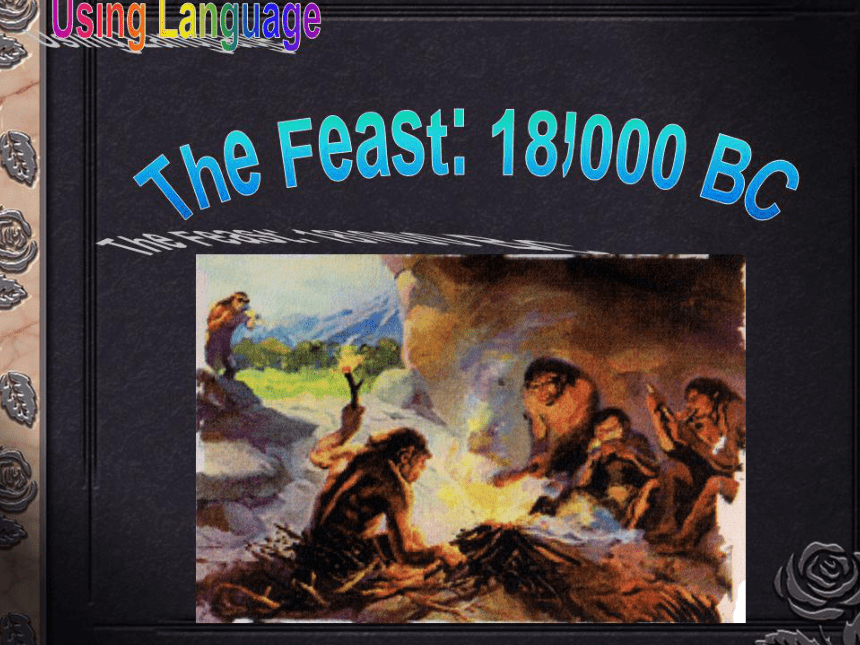 | |
| 格式 | rar | ||
| 文件大小 | 5.8MB | ||
| 资源类型 | 教案 | ||
| 版本资源 | 人教版(新课程标准) | ||
| 科目 | 英语 | ||
| 更新时间 | 2009-06-30 16:51:00 | ||
图片预览

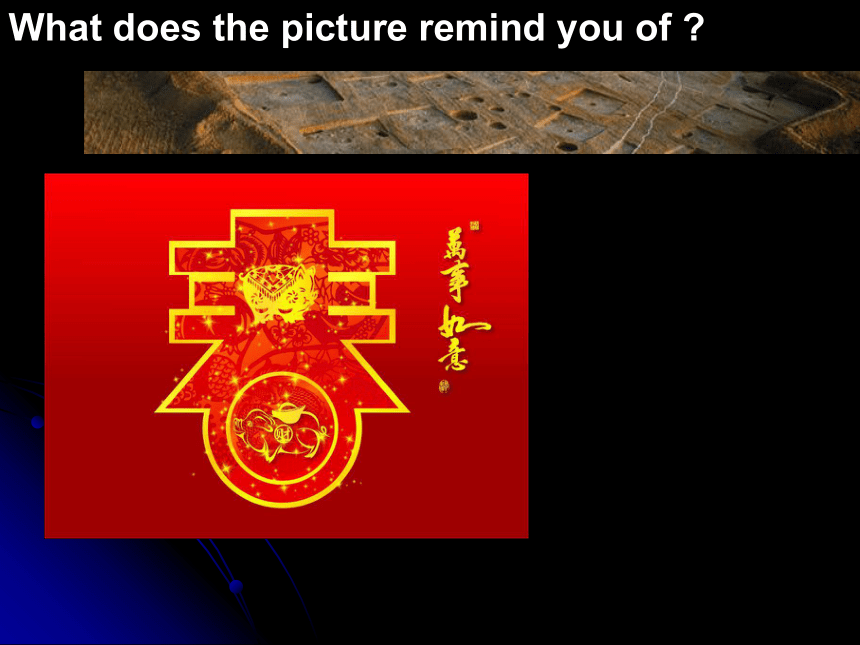
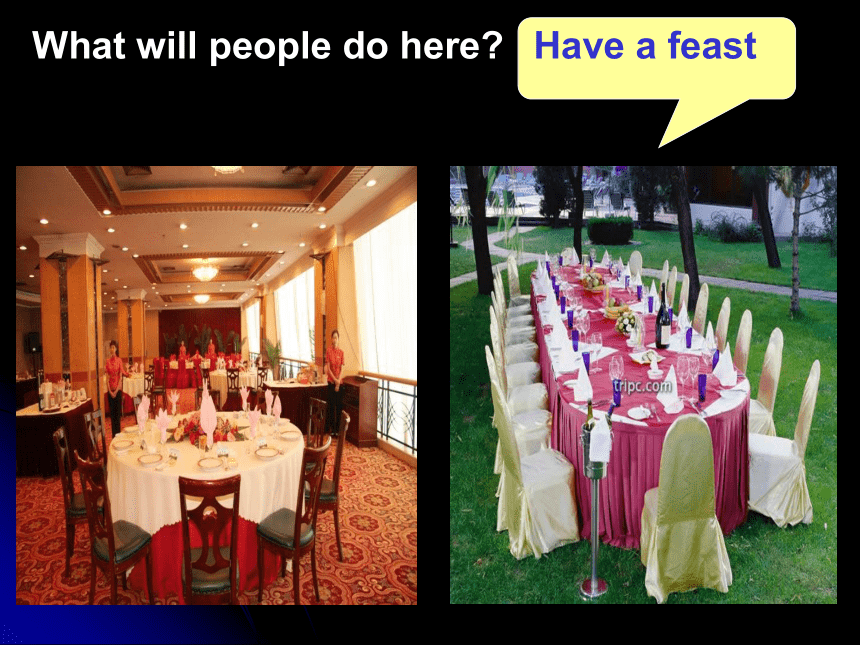
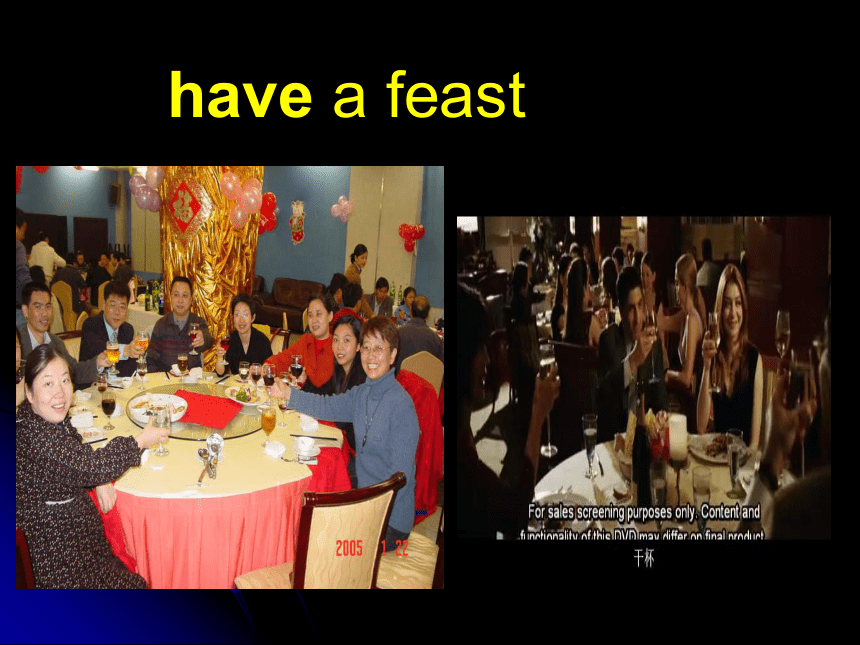

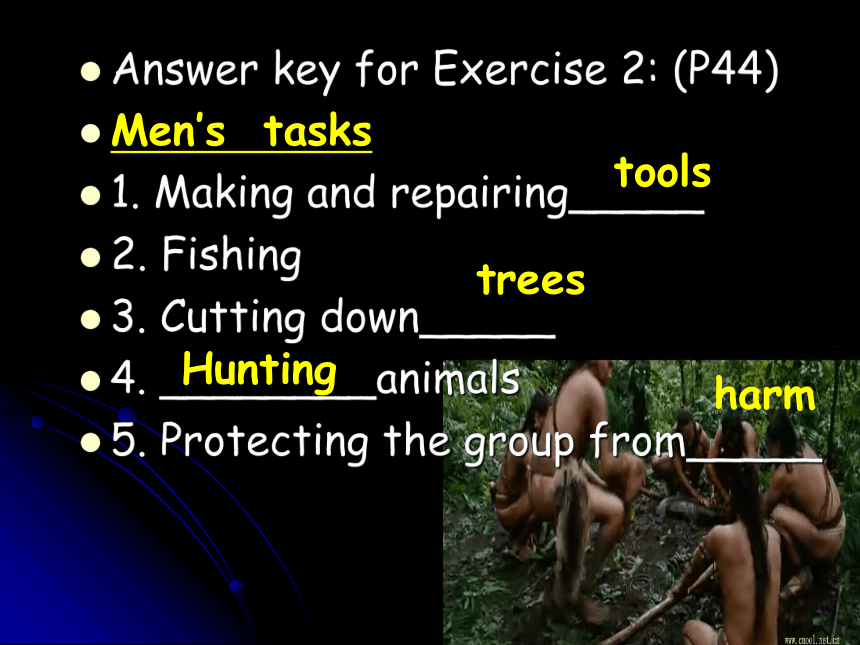
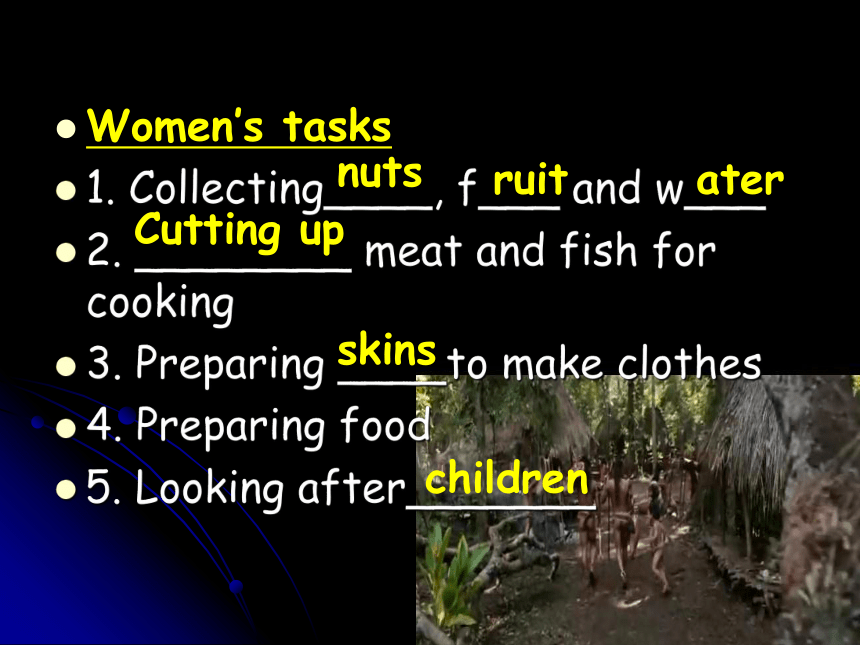
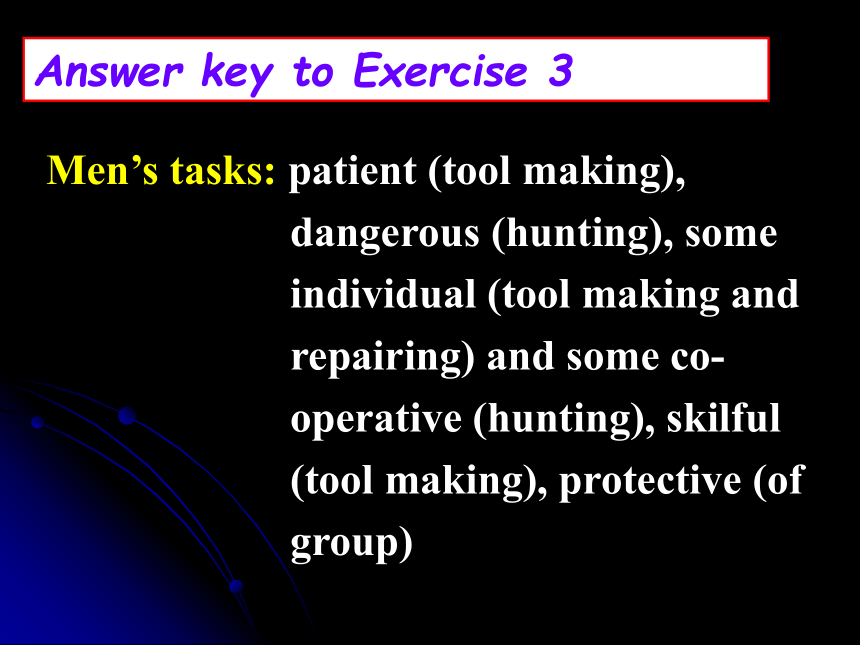
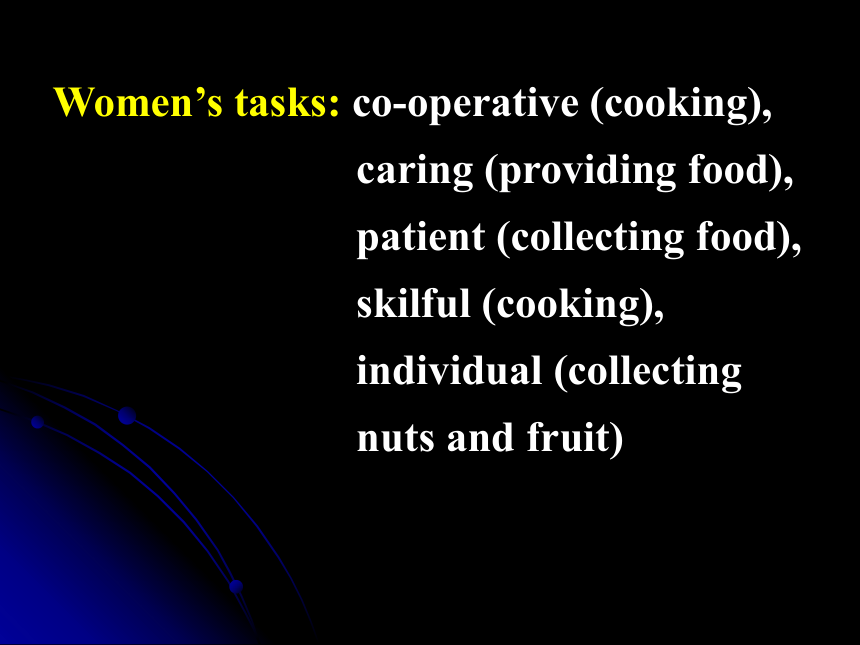
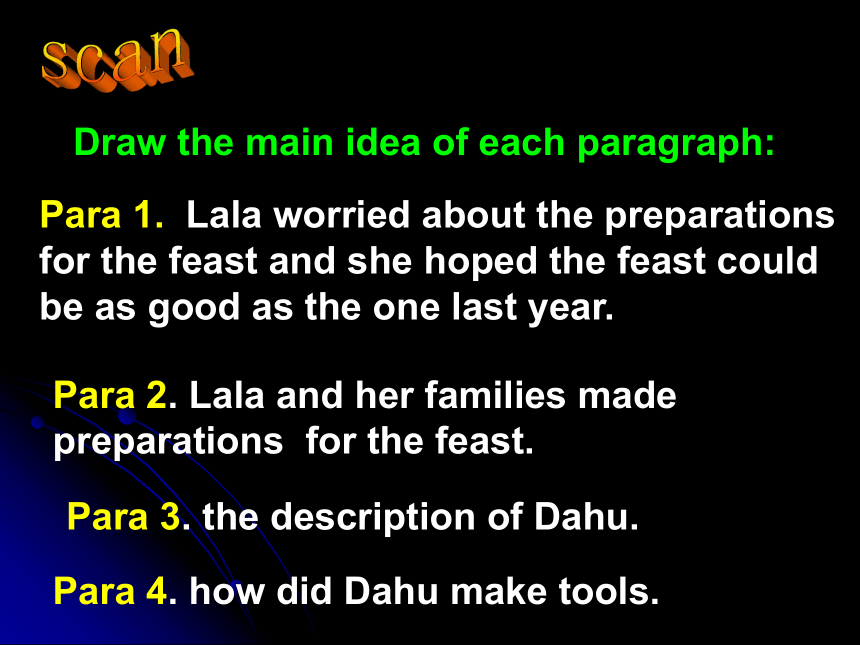
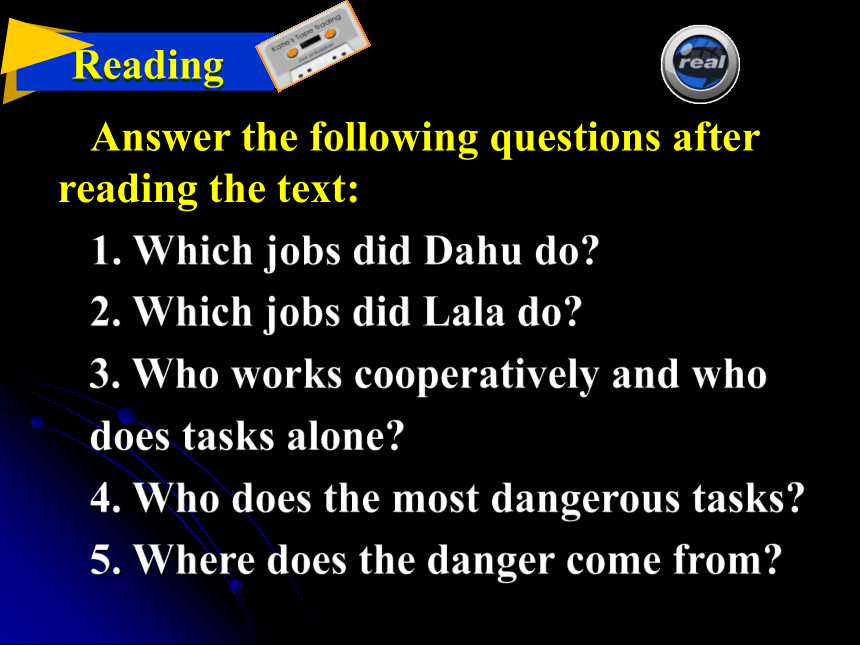
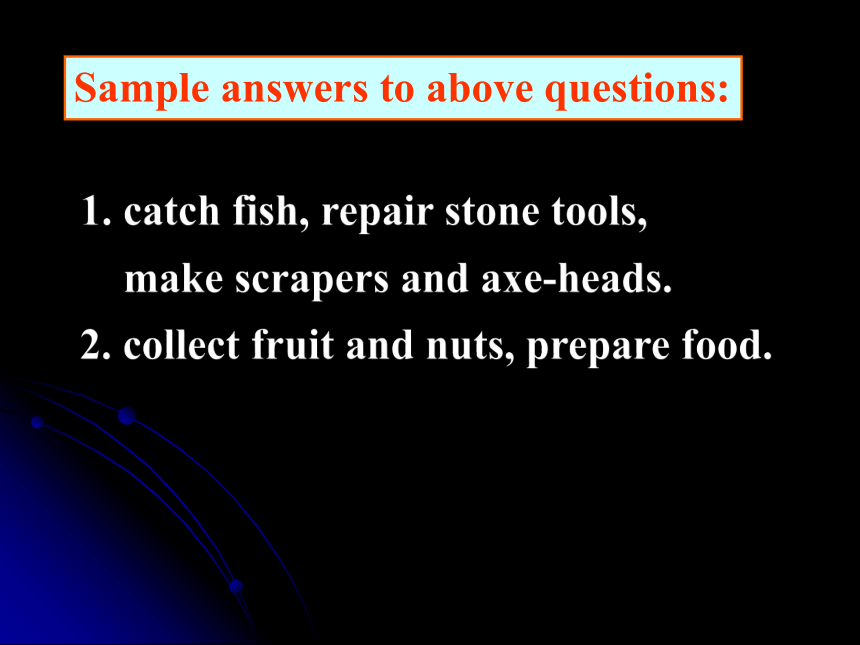
文档简介
课件51张PPT。What does the picture remind you of ?What will people do here? have a feastReading and Speaking (P43)
Answer key for Exercise 1:
DAHU: catch____,repair_________,
make s______ and ________
LALA: collect f___ and____, prepare _____fishstone toolscrapers axe-headsruitnutsfoodAnswer key for Exercise 2: (P44)
Men’s tasks
1. Making and repairing_____
2. Fishing
3. Cutting down_____
4. ________animals
5. Protecting the group from_____toolstreesHuntingharmWomen’s tasks
1. Collecting____, f___ and w___
2. ________ meat and fish for cooking
3. Preparing ____to make clothes
4. Preparing food
5. Looking after_______nutsruitaterCutting upskinschildrenAnswer key to Exercise 3 Men’s tasks: patient (tool making), dangerous (hunting), some individual (tool making and repairing) and some co-operative (hunting), skilful (tool making), protective (of group)Women’s tasks: co-operative (cooking), caring (providing food), patient (collecting food), skilful (cooking), individual (collecting nuts and fruit)Draw the main idea of each paragraph:scanPara 1. Lala worried about the preparations for the feast and she hoped the feast could be as good as the one last year.Para 2. Lala and her families made preparations for the feast.Para 3. the description of Dahu.Para 4. how did Dahu make tools. Answer the following questions after reading the text:
1. Which jobs did Dahu do?
2. Which jobs did Lala do?
3. Who works cooperatively and who
does tasks alone?
4. Who does the most dangerous tasks?
5. Where does the danger come from?Sample answers to above questions:1. catch fish, repair stone tools,
make scrapers and axe-heads.
2. collect fruit and nuts, prepare food.3. Both men and women work cooperatively. For example, Lala's mother and aunts were preparing the meat of deer and pig over the fire. Men do tasks alone.
4. Men do the most dangerous tasks.
5. The danger comes from the wild animals.Co-operative
tasks: When men go hunting or women doing cooking and preparing food, they work co-operatively. When men make or repair tools, or women collect fruit and nuts, they work alone.Answer key to Exercise 4 Where the danger
comes from: wild animals living near the cavesMost dangerous tasks:Hunting animals done by menmen and women had clearly divided tasks: fire and collecting nuts needed to be done every day but killing animals would only be done now and then. So the women's tasks were continuous and the men's tasks were more periodic. Sharing of tasks: Not having ___________ and planned better, Lala felt very worried about the preparations for her feast. So she turned for home quickly with her ________ of nuts, melons and other fruit. 根据课文内容填空。looked aheadcollectionWhen she was near home, a delicious smell _______ her progress and she became dizzy with hunger. She saw her mother and aunts _________ the deer and pig meat over the fire. Just then Dahu, her ________ , as well as the best ________ , came back with several ____ . arrestedpreparinghusbandtoolmakerfishLater he began his task: he _________ his scrapers until they were sharp enough to ______ the meat and to scrape the fish. Soon, the first of the guests began to arrive. Lala hoped it was going to be just as wonderful as last year!cut upsharpenedWords and expressions 1. If only it could be just like last year!
要是能像去年那样就好了! If only 但愿......; 要是……就好了。其后一般用虚拟语气。
If only she had looked ahead and planned better.
If only he had come. v. to express approval of (someone or something) especially by such clapping. 赞赏, 鼓掌向(某人或某物)
表示赞赏, 尤指鼓掌欢呼
Everyone applauded when the play ended.
演出结束时, 大家都热烈鼓掌。
I applaud your decision.
我赞成你的决定。2. applaud: 3. accelerate
a. to increase the speed of
加速, 促进加快…...的速度
这部新车加速效能良好。
The new car has good acceleration.
b. to cause to happen earlier (正式) 催促
他决定加快他的课程进度。
He decided to accelerate his courses. to capture and hold briefly (the attention, for example); engage 引起注意吸引并短时间吸引住(如注意力) ;吸引
花的艳丽色彩引起苏珊的注意。
The bright colors of the flowers arrested Susan’s attention. 4. arrest: having a whirling sensation and a tendency to fall 眩晕的, 眼花的感到眩晕并要摔倒的
a dizzy height 令人晕眩的高度
The old woman was dizzied by the strong wind.
那位老太太被风吹得头昏眼花。
The disaster dizzied his brain.
那场灾难弄得他头脑昏乱。 5. dizzy: 6. Abruptly she sat down, only to be
scooped up by her laughing, shouting
sister, Luna.
[考点] only to do 是不定式作结果状
语, 表示意料之外的结果。[考例] He hurried to the booking office
only ______ that all the tickets had been
sold out. (陕西2006)
A. to be told B. to tell
C. told D. telling
[点拨] tell与句子的主语he之间构成逻辑
上的动宾关系。1. The police have a______ two suspects in connection with the bank robbery.
2. The __________ (放射性的) waste should be buried deep under the ground in sealed boxes.I. 根据下列各句句意及所给单词的首字母或汉语提示, 写出各单词的正确形式。rrested radioactive练习坊3. The driver stepped on the gas and a_________ the car.
4. Americans in my neighborhood used to make their own ______ (酸乳酪).
5. The new method caught on and many peasants became very ______ (熟练的) at it.cceleratedyogurtskilful6. It was so hot in the room that she felt ____ (目眩的).
7. The audience a_________ the singer for three minutes for his excellent performance.
dizzypplauded1. Generally speaking, preparations ___ the Beijing Olympics are smoothly marching forward in accordance with plans.
2. Twenty years ago people looked _____ and thought the problem would be solved by now, but that clearly hasn’t happened.II. 用适当的介、副词填空。forahead3. Hunting spiders run after insects or lie __ wait for them.
4. She scooped __ a handful of snow and pressed it hard to make a ball.
5. He banged his head ______ the wall.
inupagainst6. I smiled __ myself and stopped working so that I could better enjoy listening to the noise.
7. I became dizzy ____ all the do’s and the don’ts, and the how’s and the why’s.
8. We have asked the Conrads to come ___ dinner on Friday evening.towithfor1. 我正在街上走, 就在这时有人从后面叫我。(when)III. 根据括号内的提示将下列句子翻译成英语。I was walking in the street when someone called me from behind.2. 我们走了很长一段路去看他,没想到他刚好去乡下了。(only to)We walked a long way to see him, only to find that he had just left for the countryside.3. 在进一步进行这件事之前, 我们必须为将来考虑。(look ahead)
4. 要是他们现在在这里, 我们就能庆祝他们的结婚纪念日了。(if only)We must look ahead before we go further into the matter.If only they were here now, we would be able to celebrate their wedding anniversary.5. 领先者在其余赛跑者加速时就逐渐失去了优势。(accelerate)
6. 她得意扬扬地摆列出她的饰品集。 (collection of)The leader is losing ground as the rest of the runners accelerate.She proudly displayed her collection of ornaments. Practice using two or more adjectives to describe the Sanxingdui Ruins objects on page 44.Homework Listening, Speaking and Reading 1. Listen to Part 1 of the tape and fill the layers in the “wastepaper basket” diagram below. yogurt potsorange skinwastepaperused envelopesListen to Part 2 and complete the passage.It uses radioactivity to measure the amount of _______ in the living things. The ________ in a dead body _________ at a ____ rate. We know how long that takes, so we can measure the amount of ______ and ________ how old a bone is.carboncarbondisappearsfixedcarbonwork outLook at this archaeological drawing of a
section showing buildings at different times
and work out the order in which they were
built. Answer key for Exercise 3: The oldest building is B because it has no layers underneath it.
The second oldest building is C because it has one layer underneath it. That layer is the remains of the building in B.
The most recent building is building A. It has two layers underneath. They are the remains of buildings B and C.Part 1
ZH: How can you tell how old the bones
are when you find them?LISTENING TEXT(P42)DATING METHODSZhou Heping has come to ask the archaeologist, Richard Leakey, how he dates the bones he finds.RL: There are two main ways: the first uses layers in the ground and the second uses the radiocarbon dating.
ZH: I see. How does the layer method work?
RL: Well, look at the diagram in your book. Think of a wastepaper basket. When you came into work, you ate an orange and threw the orange skin into it. That’s layer number 1. later somebody threw some yogurt pots into it. That’s layer number 2.
ZH: Oh yes, and then I threw some paper into it. So that’s layer number 3.
RL: Yes, and finally someone threw away some used envelopes. So how many layers are there in this wastepaper basket?
ZH: There are four layers.
RL: Which layer is the first and therefore the oldest?
ZH: The orange skin.
RL: And which is the last and therefore the most recent?
ZH: Of course—the used envelopes. I see how it works now. But how does it help?
RL: Well, layers of soil are produced at different times like the layers in your wastepaper basket. Each time people live somewhere, they make a layer in the soil. If they live there for a long time, they make a lot of layers. Each layer has a different colour and texture which we use to find out how old it is.
ZH: How splendid!Part 2
ZH: Now what about radiocarbon dating?
RL: This is more scientific. It uses radioactivity to measure the amount of carbon in living things. The carbon in a dead body disappears at a fixed rate. We know how long that takes, so we can measure the amount of carbon and work out how old a bone is.ZH: That's very clever. Is it accurate too?
RL: There are some problems with very old bones, so you are always given two dates.
ZH: How does that work? RL: Well, the date for a bone may be between 9,900 years and 10,100 years old.
ZH: Perhaps we could visit the site together sometime?
RL: Of course. Whenever you like!
Answer key for Exercise 1:
DAHU: catch____,repair_________,
make s______ and ________
LALA: collect f___ and____, prepare _____fishstone toolscrapers axe-headsruitnutsfoodAnswer key for Exercise 2: (P44)
Men’s tasks
1. Making and repairing_____
2. Fishing
3. Cutting down_____
4. ________animals
5. Protecting the group from_____toolstreesHuntingharmWomen’s tasks
1. Collecting____, f___ and w___
2. ________ meat and fish for cooking
3. Preparing ____to make clothes
4. Preparing food
5. Looking after_______nutsruitaterCutting upskinschildrenAnswer key to Exercise 3 Men’s tasks: patient (tool making), dangerous (hunting), some individual (tool making and repairing) and some co-operative (hunting), skilful (tool making), protective (of group)Women’s tasks: co-operative (cooking), caring (providing food), patient (collecting food), skilful (cooking), individual (collecting nuts and fruit)Draw the main idea of each paragraph:scanPara 1. Lala worried about the preparations for the feast and she hoped the feast could be as good as the one last year.Para 2. Lala and her families made preparations for the feast.Para 3. the description of Dahu.Para 4. how did Dahu make tools. Answer the following questions after reading the text:
1. Which jobs did Dahu do?
2. Which jobs did Lala do?
3. Who works cooperatively and who
does tasks alone?
4. Who does the most dangerous tasks?
5. Where does the danger come from?Sample answers to above questions:1. catch fish, repair stone tools,
make scrapers and axe-heads.
2. collect fruit and nuts, prepare food.3. Both men and women work cooperatively. For example, Lala's mother and aunts were preparing the meat of deer and pig over the fire. Men do tasks alone.
4. Men do the most dangerous tasks.
5. The danger comes from the wild animals.Co-operative
tasks: When men go hunting or women doing cooking and preparing food, they work co-operatively. When men make or repair tools, or women collect fruit and nuts, they work alone.Answer key to Exercise 4 Where the danger
comes from: wild animals living near the cavesMost dangerous tasks:Hunting animals done by menmen and women had clearly divided tasks: fire and collecting nuts needed to be done every day but killing animals would only be done now and then. So the women's tasks were continuous and the men's tasks were more periodic. Sharing of tasks: Not having ___________ and planned better, Lala felt very worried about the preparations for her feast. So she turned for home quickly with her ________ of nuts, melons and other fruit. 根据课文内容填空。looked aheadcollectionWhen she was near home, a delicious smell _______ her progress and she became dizzy with hunger. She saw her mother and aunts _________ the deer and pig meat over the fire. Just then Dahu, her ________ , as well as the best ________ , came back with several ____ . arrestedpreparinghusbandtoolmakerfishLater he began his task: he _________ his scrapers until they were sharp enough to ______ the meat and to scrape the fish. Soon, the first of the guests began to arrive. Lala hoped it was going to be just as wonderful as last year!cut upsharpenedWords and expressions 1. If only it could be just like last year!
要是能像去年那样就好了! If only 但愿......; 要是……就好了。其后一般用虚拟语气。
If only she had looked ahead and planned better.
If only he had come. v. to express approval of (someone or something) especially by such clapping. 赞赏, 鼓掌向(某人或某物)
表示赞赏, 尤指鼓掌欢呼
Everyone applauded when the play ended.
演出结束时, 大家都热烈鼓掌。
I applaud your decision.
我赞成你的决定。2. applaud: 3. accelerate
a. to increase the speed of
加速, 促进加快…...的速度
这部新车加速效能良好。
The new car has good acceleration.
b. to cause to happen earlier (正式) 催促
他决定加快他的课程进度。
He decided to accelerate his courses. to capture and hold briefly (the attention, for example); engage 引起注意吸引并短时间吸引住(如注意力) ;吸引
花的艳丽色彩引起苏珊的注意。
The bright colors of the flowers arrested Susan’s attention. 4. arrest: having a whirling sensation and a tendency to fall 眩晕的, 眼花的感到眩晕并要摔倒的
a dizzy height 令人晕眩的高度
The old woman was dizzied by the strong wind.
那位老太太被风吹得头昏眼花。
The disaster dizzied his brain.
那场灾难弄得他头脑昏乱。 5. dizzy: 6. Abruptly she sat down, only to be
scooped up by her laughing, shouting
sister, Luna.
[考点] only to do 是不定式作结果状
语, 表示意料之外的结果。[考例] He hurried to the booking office
only ______ that all the tickets had been
sold out. (陕西2006)
A. to be told B. to tell
C. told D. telling
[点拨] tell与句子的主语he之间构成逻辑
上的动宾关系。1. The police have a______ two suspects in connection with the bank robbery.
2. The __________ (放射性的) waste should be buried deep under the ground in sealed boxes.I. 根据下列各句句意及所给单词的首字母或汉语提示, 写出各单词的正确形式。rrested radioactive练习坊3. The driver stepped on the gas and a_________ the car.
4. Americans in my neighborhood used to make their own ______ (酸乳酪).
5. The new method caught on and many peasants became very ______ (熟练的) at it.cceleratedyogurtskilful6. It was so hot in the room that she felt ____ (目眩的).
7. The audience a_________ the singer for three minutes for his excellent performance.
dizzypplauded1. Generally speaking, preparations ___ the Beijing Olympics are smoothly marching forward in accordance with plans.
2. Twenty years ago people looked _____ and thought the problem would be solved by now, but that clearly hasn’t happened.II. 用适当的介、副词填空。forahead3. Hunting spiders run after insects or lie __ wait for them.
4. She scooped __ a handful of snow and pressed it hard to make a ball.
5. He banged his head ______ the wall.
inupagainst6. I smiled __ myself and stopped working so that I could better enjoy listening to the noise.
7. I became dizzy ____ all the do’s and the don’ts, and the how’s and the why’s.
8. We have asked the Conrads to come ___ dinner on Friday evening.towithfor1. 我正在街上走, 就在这时有人从后面叫我。(when)III. 根据括号内的提示将下列句子翻译成英语。I was walking in the street when someone called me from behind.2. 我们走了很长一段路去看他,没想到他刚好去乡下了。(only to)We walked a long way to see him, only to find that he had just left for the countryside.3. 在进一步进行这件事之前, 我们必须为将来考虑。(look ahead)
4. 要是他们现在在这里, 我们就能庆祝他们的结婚纪念日了。(if only)We must look ahead before we go further into the matter.If only they were here now, we would be able to celebrate their wedding anniversary.5. 领先者在其余赛跑者加速时就逐渐失去了优势。(accelerate)
6. 她得意扬扬地摆列出她的饰品集。 (collection of)The leader is losing ground as the rest of the runners accelerate.She proudly displayed her collection of ornaments. Practice using two or more adjectives to describe the Sanxingdui Ruins objects on page 44.Homework Listening, Speaking and Reading 1. Listen to Part 1 of the tape and fill the layers in the “wastepaper basket” diagram below. yogurt potsorange skinwastepaperused envelopesListen to Part 2 and complete the passage.It uses radioactivity to measure the amount of _______ in the living things. The ________ in a dead body _________ at a ____ rate. We know how long that takes, so we can measure the amount of ______ and ________ how old a bone is.carboncarbondisappearsfixedcarbonwork outLook at this archaeological drawing of a
section showing buildings at different times
and work out the order in which they were
built. Answer key for Exercise 3: The oldest building is B because it has no layers underneath it.
The second oldest building is C because it has one layer underneath it. That layer is the remains of the building in B.
The most recent building is building A. It has two layers underneath. They are the remains of buildings B and C.Part 1
ZH: How can you tell how old the bones
are when you find them?LISTENING TEXT(P42)DATING METHODSZhou Heping has come to ask the archaeologist, Richard Leakey, how he dates the bones he finds.RL: There are two main ways: the first uses layers in the ground and the second uses the radiocarbon dating.
ZH: I see. How does the layer method work?
RL: Well, look at the diagram in your book. Think of a wastepaper basket. When you came into work, you ate an orange and threw the orange skin into it. That’s layer number 1. later somebody threw some yogurt pots into it. That’s layer number 2.
ZH: Oh yes, and then I threw some paper into it. So that’s layer number 3.
RL: Yes, and finally someone threw away some used envelopes. So how many layers are there in this wastepaper basket?
ZH: There are four layers.
RL: Which layer is the first and therefore the oldest?
ZH: The orange skin.
RL: And which is the last and therefore the most recent?
ZH: Of course—the used envelopes. I see how it works now. But how does it help?
RL: Well, layers of soil are produced at different times like the layers in your wastepaper basket. Each time people live somewhere, they make a layer in the soil. If they live there for a long time, they make a lot of layers. Each layer has a different colour and texture which we use to find out how old it is.
ZH: How splendid!Part 2
ZH: Now what about radiocarbon dating?
RL: This is more scientific. It uses radioactivity to measure the amount of carbon in living things. The carbon in a dead body disappears at a fixed rate. We know how long that takes, so we can measure the amount of carbon and work out how old a bone is.ZH: That's very clever. Is it accurate too?
RL: There are some problems with very old bones, so you are always given two dates.
ZH: How does that work? RL: Well, the date for a bone may be between 9,900 years and 10,100 years old.
ZH: Perhaps we could visit the site together sometime?
RL: Of course. Whenever you like!
